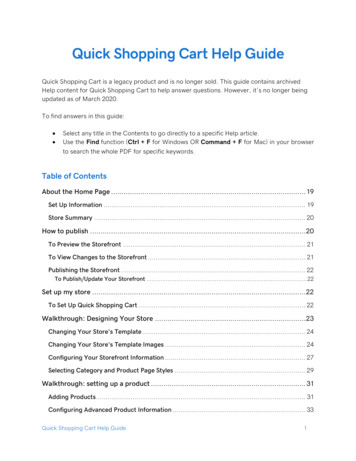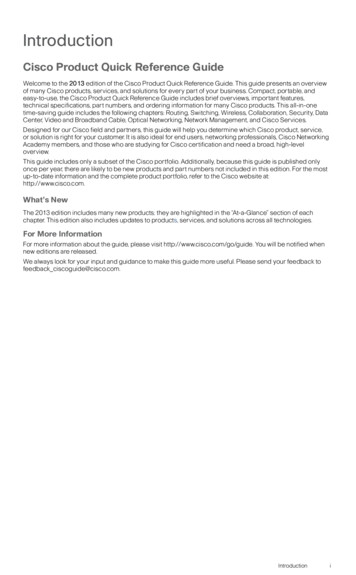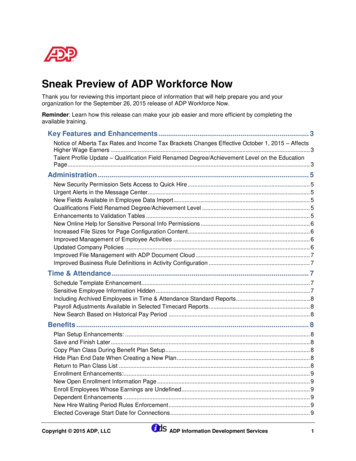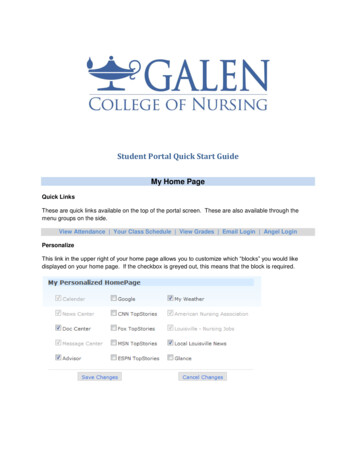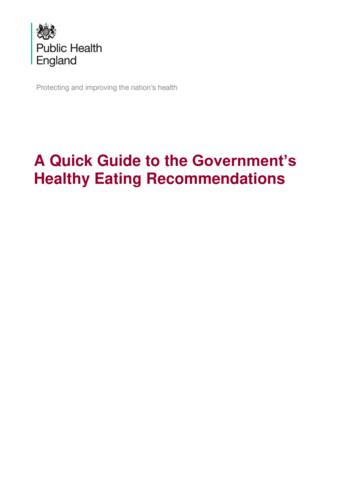
Transcription
A Quick Guide to the Government’sHealthy Eating Recommendations
A Quick Guide to the Government’s Healthy Eating RecommendationsAbout Public Health EnglandPublic Health England exists to protect and improve the nation’s health and wellbeing,and reduce health inequalities. We do this through world-leading science, knowledgeand intelligence, advocacy, partnerships and the delivery of specialist public healthservices. We are an executive agency of the Department of Health and Social Care,and a distinct delivery organisation with operational autonomy. We providegovernment, local government, the NHS, Parliament, industry and the public withevidence-based professional, scientific and delivery expertise and support.Public Health EnglandWellington House133-155 Waterloo RoadLondon SE1 8UGTel: 020 7654 8000www.gov.uk/pheTwitter: @PHE ukFacebook: www.facebook.com/PublicHealthEnglandPrepared by: Nutrition Advice Team, Public Health England Crown copyright 2018You may re-use this information (excluding logos) free of charge in any format ormedium, under the terms of the Open Government Licence v3.0. To view this licence,visit OGL. Where we have identified any third party copyright information you will needto obtain permission from the copyright holders concerned.Published September 2018PHE publicationsgateway number: 2014220PHE supports the UNSustainable Development Goals2
A Quick Guide to the Government’s Healthy Eating RecommendationsContentsAbout Public Health England2Contents31.Executive summary42.The Eatwell Guide53.Government healthy eating recommendations64.Further information11References123
A Quick Guide to the Government’s Healthy Eating Recommendations1. Executive summary1.1.This document has been updated to reflect recent changes to governmentdietary recommendations. The original Quick Guide to Government HealthyEating Recommendations has been available on the Healthier and moreSustainable Catering webpage on GOV.UK since February 2014.1.2.This document is aimed at catering providers to support healthier cateringprovision, health professionals (including dietitians and nutritionists), teachers,university students, academics, industry and is also a source of information forthe general population. It provides a summary of government dietary advice andnutrient recommendations throughout the lifecourse.1.3.Government healthy eating recommendations are visually depicted in theEatwell Guide1 and are based on recommendations from the World HealthOrganisation (WHO)2,3, Committee on Medical Aspects of Food Policy(COMA)4,5 and the Scientific Advisory Committee on Nutrition (SACN)6,7,8,9,10,11that succeeded COMA in 2000.1.4.This document provides a concise summary of government’s healthy eatingrecommendations and signposts to the evidence upon which they are based.4
A Quick Guide to the Government’s Healthy Eating Recommendations2. The Eatwell Guide2.1.The Eatwell Guide (below) is a pictorial representation of government healthyeating advice showing the proportions in which different types of foods areneeded to have a well-balanced and healthy diet. The proportions shown arerepresentative of your food consumption over the period of a day or even aweek, not necessarily each meal time.
A Quick Guide to the Government’s Healthy Eating Recommendations3. Government healthy eating recommendations3.1.Eatwell Guide food groups and supporting informationFruit and vegetablesOver a third of the diet should come from fruit andvegetables.Eat at least 5 portions of a variety of fruit andvegetables every day. A portion is 80g or one of thefollowing: a slice of a large fruit such as a melona whole piece of fruit such as an apple or bananatwo pieces of small fruit such as satsumasthree tablespoons of cooked vegetablesa bowl of mixed saladLimit the consumption of 100% fruit and vegetable juicesand/or smoothies to a combined total of 150ml (oneportion) per day and consume with meals to reduce the riskof tooth decay.30g (1 heaped tablespoon) of dried fruit (such asraisins and apricots) also counts as one portion.Consume at mealtimes rather than as a betweenmeal snack to reduce the risk of tooth decay.Potatoes, bread, rice, pasta and other starchy carbohydratesBase meals on potatoes, bread, rice, pasta or other starchycarbohydrates; choosing wholegrain versions wherepossible. This includes wholewheat pasta, brown rice, orsimply leaving the skins on potatoes.Wholegrain food contains more fibre than white or refinedstarchy food, and often more of other nutrients too.
A Quick Guide to the Government’s Healthy Eating RecommendationsDairy and alternativesHave some dairy and alternatives; choosing lower fat andlower sugar options.Look at labels and choose milks lower in fat, such asskimmed, 1% or semi-skimmed; yoghurts lower in fat andsugar and cheeses lower in fat and salt.When buying dairy alternatives like soya drinks, go forunsweetened, calcium-fortified versions.Beans, pulses, fish, eggs, meat and other proteinsEat some beans, pulses, fish, eggs, meat and otherproteins (including 2 portions of fish every week, one ofwhich should be oily).Beans, peas and lentils (which are all types of pulses) aregood alternatives to meat because they’re naturally verylow in fat, and they’re high in fibre, protein, vitamins andminerals. Try adding them to soups, stews and ragùs tomake your meal go further.Aim for at least two portions (2 x 140g) of fish a week,including a portion of oily fish. Oily fish includes salmon,sardines, mackerel and kippers.On average eat no more than 70g red and processed meata day. Processed meat includes sausages, bacon, curedmeats and reformed meat products.Some types of meat are high in fat, particularly saturatedfat. When buying meat: choose lean cuts of meat go for leaner mince cut the fat off of meat and the skin off of chicken try to grill or steam meat and fish instead of frying7
A Quick Guide to the Government’s Healthy Eating RecommendationsOil and spreadsChoose unsaturated oils and spreads and eat in small amounts.Although some fat in the diet is essential, generally we areeating too much saturated fat.Unsaturated fats are healthier fats that are usually fromplant sources and in liquid form as oil. This includesvegetable oil, rapeseed oil and olive oil; as well as spreadsmade from these oils.All types of fat are high in energy and should be limited inthe diet.Foods high in fat, salt and sugarEat less often and in small amounts.This includes products such as chocolate, cakes, biscuits,full-sugar soft drinks, butter, cream and ice-cream.These foods are not needed in the diet and so, if included,should only be consumed infrequently and insmall amounts.Check the label and avoid foods which are high in fat, saltand sugar.Aim to drink 6-8 glasses of fluid every dayWater, lower fat milk and sugar-free drinks including teaand coffee all count.100% fruit and vegetable juices and smoothies also counttowards your fluid consumption, although they are a sourceof free sugars and so you should limit consumption to nomore than a combined total of 150ml per day.8
A Quick Guide to the Government’s Healthy Eating RecommendationsSwap sugary soft drinks for diet, sugar-free or no addedsugar varieties to reduce your sugar intake in a simplestep.Food labellingFood labels can help you to choosebetween foods and to pick those that arelower in energy, fat, saturated fat, sugarsand salt.Where colour coded labels are used you can tell at a glance if they arehigh, medium or low in fat, saturated fat, sugars and salt.For a healthier choice, try to pick products with more greens and ambersand fewer reds.Daily energy requirementsWe all need different amounts of energy (or calories) from food to be ahealthy weight. How much you need depends on a number of factors,including how active you are. Whenever we eat more than our bodyneeds, we put on weight.The average energy requirement for a man is about 10.5 MJ (2,500 kcal);8.4MJ (2,000 kcal) for a woman. For more information on nutrientrequirements please see the link provided in the Government DietaryRecommendations section below.By conventioni: breakfast should provide about 1.7 MJ/400kcal of your energy lunch about 2.5 MJ/600kcal evening meal about 2.5 MJ/600kcal leaving 1.7 MJ/ 400kcal for all the snacks and drinks consumedbetween mealsiThe information provided is based on the average energy requirements for a woman (2000kcal per day)9
A Quick Guide to the Government’s Healthy Eating Recommendations3.2.SupplementsMost of us can get all the nutrients we need by consuming a healthy,balanced and varied diet. However, there are certain groups of thepopulation for whom certain dietary supplements are recommended:Folic acidWomen who could become pregnant or who are planning apregnancy should take a dietary supplement of 400 micrograms (µg) offolic acid every day from before conception until the 12th week ofpregnancy, to reduce the risk of neural tube defects (NTDs) such as spinabifida.Women who have an increased risk of having a pregnancy affected by anNTD, including those who had a previous NTD affected pregnancy andthose with a family history of NTDs, are advised to take a higher dose of 5milligrams (mg) of folic acid each day until the 12th week of pregnancy.In addition to taking folic acid supplements, all pregnant women should eatfolate rich foods such as green vegetables, some fruits (oranges forexample) and fortified breakfast cereals.Vitamin DIt is recommended6 that between the months of October and Marcheveryone aged five years and above including pregnant andbreastfeeding women should consider taking a supplement containing10µg of vitamin D per dayii. There are separate recommendations forchildren from birth to four years of age.Between late March/early April and the end of September, the majority of peopleaged five years and above will probably obtain sufficient vitamin D from sunlightwhen they are outdoors so they might choose not to take a vitamin D supplementduring these months.However, some groups of people will not obtain enough vitamin D from sunlightbecause they have very little or no sunshine exposure. People from these groupsiiThis is due to the fact that vitamin D is only found in a small number of foods and so it might be difficult to getenough from foods that naturally contain vitamin D and/or fortified foods alone. This recommendation refers to theaverage amount of vitamin D consumed over a period of time (eg a week) and takes account of day to dayvariations in vitamin D intake.10
A Quick Guide to the Government’s Healthy Eating Recommendationsshould take a daily supplement containing 10µg vitamin D throughout the year.They are: people who are seldom outdoors such as frail or housebound individuals andthose who are confined indoors eg in institutions such as care homes people who habitually wear clothes that cover most of their skin while outdoorsPeople from minority ethnic groups with dark skin such as those with African,African-Caribbean and South Asian origin might not get enough vitamin D fromsunlight in summer, so they should consider taking a daily supplement containing10µg vitamin D throughout the year.Vitamins A and CInfants and young children aged between six months and five yearsshould also be given a supplement containing vitamins A and C. Babiesunder six months of age should not need supplements containing vitamin Aand C as their body stores of nutrients (obtained from the mother duringpregnancy) and breast milk or infant formula intake should be adequate tomeet their needs. Formula fed infants should not need vitaminsupplements until they are having less than 500ml of formula a day, asformula is fortified with vitamins and minerals.Children who have a good appetite and eat a wide variety of foods,including fruit and vegetables, might not need vitamin supplements.Parents who are concerned about their child’s diet should talk to their GPor health visitor for further advice.4. Further information4.1.The Eatwell Guide, associated reports and supporting dietary messagesare available at: wellguide4.2.Government dietary recommendations for food energy and nutrients formales and females aged 1-18 years and 19 years are also available viathis link. This includes recommendations for food energy, macronutrients,micronutrients, salt, free sugar and dietary /uploads/attachment data/file/547050/government dietary recommendations.pdf11
A Quick Guide to the Government’s Healthy Eating RecommendationsReferences1The Eatwell Guide and all supporting information are available e-eatwell-guide2World Health Organisation. Diet, nutrition and the prevention of chronic diseases. 2003.Available from: http://whqlibdoc.who.int/trs/WHO TRS 916.pdf3World Health Organisation. Diet, nutrition and the prevention of chronic diseases. 1990.Available from: WHO TRS 797/en/index.html4Department of Health. Report on health and social subjects 46 nutritional aspects ofcardiovascular disease. Report of the cardiovascular review group Committee on MedicalAspects of Food Policy. London: HMSO; 19945Committee on Medical Aspects of Food Policy. Dietary Reference Values for Food Energyand Nutrients for the United Kingdom. London: HMSO; 19916Scientific Advisory Committee on Nutrition. Vitamin D and Health. London: TSO; 2016.Available from: tamin-d-and-health-report7Scientific Advisory Committee on Nutrition. Carbohydrates and Health. London: TSO; 2015.Available from: rbohydrates-and-healthreport8Scientific Advisory Committee on Nutrition. Dietary Reference Values for Energy. London:TSO; 2011. Available from: etaryreference-values-for-energy9Scientific Advisory Committee on Nutrition. Iron and Health. London: TSO; 2010. Availablefrom: on-and-health-report10Scientific Advisory Committee on Nutrition. Advice on Fish Consumption: Benefits and Risks.London: TSO; 2004. Available from: viceon-fish-consumption11Scientific Advisory Committee on Nutrition. Salt and Health. TSO; London: 2003. Availablefrom: lt-and-health-report12
A Quick Guide to the Government’s Healthy Eating Recommendations 3. Government healthy eating recommendations 3.1. Eatwell Guide food groups and supporting information Fruit and vegetables Over a third of the diet should come from fruit and vegetables. Eat at least 5
